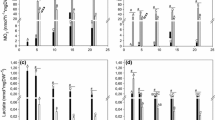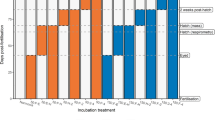Abstract
The aim of this study was to determine the influence of different levels of dissolved oxygen (DO) on embryonic development (ED) and hatching success of Greenland halibut (Reinhardtius hippoglossoides) eggs. Fertilized eggs from six females were exposed to five DO levels: severely hypoxic (10 and 20 %sat [percent saturation]), moderately hypoxic (35 and 50 %sat), and normoxic (100 %sat). Greenland halibut eggs were highly tolerant to hypoxia, with hatching occurring at levels as low as 20 %sat. In severely hypoxic conditions (10 %sat), ED was impaired and no hatching occurred. Lipid composition, during ED, changed as a function of female origin and DO levels. Phospholipids were the dominant lipid class in eggs. Although triacylglycerols were a minor lipid class in terms of abundance, they were only used under severe hypoxia. The results suggest that severe hypoxia (between 10 and 20 %sat) has detrimental effect on the early development of Greenland halibut and may result in reduced recruitment and lower population abundance if the decreasing trend in the DO levels observed in the bottom waters of the Gulf of St. Lawrence continues in the future. Other species that share similar life histories may also be at risk.




Similar content being viewed by others
References
Ådlandsvik B, Oempty R, Gundersen AC, Nedreaas KH, Stene A, Albert OT (2004) Modelling the advection and diffusion of eggs and larvae of Greenland halibut (Reinhardtius hippoglossoides) in the north-east Arctic. Fish Oceanogr 13:403–415
Bishop YMM (1969) Full contingency tables, logits, and split contingency tables. Biometrics 25:383–399
Breitburg DL, Adamack A, Rose KA, Kolesar SE, Decker MB, Purcell JE, Keister JE, Cowan JH (2003) The pattern and influence of low dissolved oxygen in the Patuxent River, a seasonally hypoxic estuary. Estuaries 26:280–297
Chaffee C, Strathmann RR (1984) Constraints on egg masses. I. Retarded development within thick egg masses. J Exp Mar Biol Ecol 84:73–83
Cowey C, Bell J, Knox D, Fraser A, Youngson A (1985) Lipids and lipid antioxidant systems in developing eggs of salmon (Salmo salar). Lipids 20:567–572
Czerkies P, Kordalski K, Golas T, Krysinski D, Luczynski M (2002) Oxygen requirements of whitefish and vendace (Coregoninae) embryos at final stages of their development. Aquaculture 211:375–385
Davenport J (1983) Oxygen and the developing eggs and larvae of the lumpfish, Cyclopterus lumpus. Mar Biol Assoc UK 63:633–640
Desvilettes C, Bourdier G, Breton JC (1997) Changes in lipid class and fatty acid composition during development in pike (Esox lucius L) eggs and larvae. Fish Physiol Biochem 16:381–393
DFO (2006) Assessment of the Greenland halibut stock in the Gulf of St. Lawrence (4RST) in 2005. C S A S DFO Can Sci Advis Rep 2006/011:13
Diaz RJ (2001) Overview of hypoxia around the world. J Environ Qual 30:275–281
Evans RP, Parrish CC, Brown JA, Davis PJ (1996) Biochemical composition of eggs from repeat and first-time spawning captive Atlantic halibut (Hippoglossus hippoglossus). Aquaculture 139:139–149
Falk-Petersen S, Sargent JR, Fox C, Falk-Petersen IB, Haug T, Kjørsvik E (1989) Lipids in Atlantic halibut (Hippoglossus hippoglossus) eggs from planktonic samples in Northern Norway. Mar Biol 101:553–556
Finn RN, Fyhn HJ, Evjen MS (1995) Physiological energetics of developing embryos and yolk-sac larvae of Atlantic cod (Gadus morhua). I. Respiration and nitrogen metabolism. Mar Biol 124:355–369
Folch J, Lees M, Sloanestanley GH (1957) A simple method for the isolation and purification of total lipids from animals tissues. J Biol Chem 226:497–509
Gilbert D, Sundby B, Gobeil C, Mucci A, Tremblay GH (2005) A seventy-two-year record of diminishing deep-water oxygen in the St. Lawrence estuary: the northwest Atlantic connection. Limnol Oceanogr 50:1654–1666
Gundersen AC, Rønneberg JE, Boje J (2001) Fecundity of Greenland halibut (Reinhardtius hippoglossoides Walbaum) in East Greenland waters. Fish Res 51:229–236
Hassell KL, Coutin PC, Nugegoda D (2008) Hypoxia impairs embryo development and survival in black bream (Acanthopagrus butcheri). Mar Pollut Bull 57:302–306
Helvik JV, Walther BT (1993) Environmental parameters affecting induction of hatching in halibut (Hippoglossus hippoglossus) embryos. Mar Biol 116:39–45
Jelmert A, Rabben H (1987) Upwelling incubators for eggs of the Atlantic halibut (Hippoglossus hippoglossus L.). Int Counc Explor Sea Comm Meet 20:1–8
Kamler E (2005) Parent-egg-progeny relationships in teleost fishes: an energetics perspective. Rev Fish Biol Fisher 15:399–421
Kjørsvik E, Mangor-Jensen A, Holmefjord I (1990) Egg Quality in fishes. In: Blaxter JHS, Southward AJ (eds) Advances in marine biology, vol 26. Academic Press, London, pp 71–113
Lim HS, Diaz RJ, Hong JS, Schaffner LC (2006) Hypoxia and benthic community recovery in Korean coastal waters. Mar Pollut Bull 52:1517–1526
Lutz RV, Marcus NH, Chanton JP (1992) Effects of low oxygen concentrations on the hatching and viability of eggs of marine calanoid copepods. Mar Biol 114:241–247
Malcolm IA, Youngson AF, Soulsby C (2003) Survival of salmonid eggs in a degraded gravel-bed stream: effects of groundwater–surface water interactions. Riv Res Appl 19:303–316
McCormick PG (1972) The determination of dissolved oxygen by the winkler method: a student laboratory experiment. J Chem Educ 49:839–841
Mejri S (2011) Détermination de l’influence de différentes teneurs en oxygène dissous (OD) sur le succès d’éclosion et d’embryogenèse chez le flétan de Groenland (Reinhardtius hippoglossoides). Dissertation, Université du Québec à Rimouski, Québec
Mills NE, Barnhart MC (1999) Effect of hypoxia on embryonic development in two Ambystoma and two Rana species. University of Chicago Press, Chicago, IL, USA
Mourente G, Vázquez R (1996) Changes in the content of total lipid, lipid classes and their fatty acids of developing eggs and unfed larvae of the Senegal sole (Solea senegalensis). Fish Physiol Biochem 15:221–235
Oppen-Berntsen DO, Bogsnes A, Walther BT (1990) The effects of hypoxia, alkalinity and neurochemicals on hatching of Atlantic salmon (Salmo salar) eggs. Aquaculture 86:417–430
Parrish C (1987) Separation of aquatic lipid classes by chromarod thin-layer chromatography with measurement by Iatroscan Flame Ionization detection. Can J Fish Aquat Sci 44:722–731
Parrish CC (1999) Determination of total lipid, lipid classes, and fatty acids in aquatic samples. In: Arts MT, Wainman BC (eds) Lipids in freshwater ecosystems. Springer, New York, pp 4–20
Plante S, Chabot D, Dutil JD (1998) Hypoxia tolerance in Atlantic cod. J Fish Biol 53:1342–1356
Rainuzzo JR, Reitan KI, Olsen Y (1997) The significance of lipids at early stages of marine fish: a review. Aquaculture 155:103–115
Sewall FF, Rodgveller CJ (2008) Changes in body composition and fatty acid profile during embryogenesis of quillback rockfish (Sebastes maliger). Fish Bull 107:207–220
Shardo JD (1995) Comparative embryology of teleostean fishes. I. Development and staging of the american shad, Alosa sapidissima (Wilson, 1811). J Morphol 225:125–167
Stene A, Gundersen AC, Albert OT, Nedreaas KH, Solemdal P (1999) Early development of Northeast Arctic Greenland halibut (Reinhardtius hippoglossoides). J North Atl Fish Sci 25:171–177
Verreth J, Custers G, Melger W (1994) The metabolism of neutral and polar lipids in eleuthero-embryos and starving larvae of the African catfish Clarias gariepinw. J Fish Biol 45:961–971
White A, Fletcher TC (1987) Polar and neutral lipid composition of the gonads and serum of the plaice Pleuronectes platessa L. Fish Physiol Biochem 4:37–43
Wiegand MD (1996) Composition, accumulation and utilization of yolk lipids in teleost fish. Rev Fish Biol Fisher 6:259–286
Zhao H (2007) A multi-objective genetic programming approach to developing Pareto optimal decision trees. Decis Support Syst 43:809–826
Acknowledgments
We are grateful to Dr D. Chabot for his help with the experimental set-up for dissolved oxygen. We also thank I. Redjah, M. Peloquin, and M. C. Lamarche for assistance in the laboratory and the field. The Natural Sciences and Engineering Research Council of Canada and the Canadian department of Fisheries and Oceans provided the financial support for this project. Finally, we would like to thank the two anonymous reviewers for their constructive comments on the manuscript.
Author information
Authors and Affiliations
Corresponding author
Additional information
Communicated by M. A. Peck.
Rights and permissions
About this article
Cite this article
Mejri, S., Tremblay, R., Lambert, Y. et al. Influence of different levels of dissolved oxygen on the success of Greenland halibut (Reinhardtius hippoglossoides) egg hatching and embryonic development. Mar Biol 159, 1693–1701 (2012). https://doi.org/10.1007/s00227-012-1957-y
Received:
Accepted:
Published:
Issue Date:
DOI: https://doi.org/10.1007/s00227-012-1957-y




